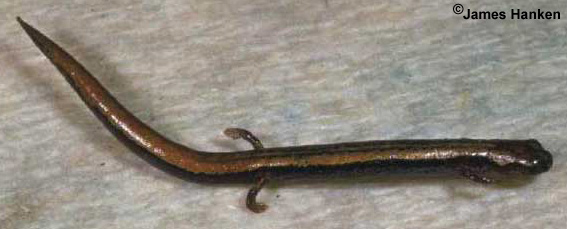 Expert annotations for this species! See below. Expert annotations for this species! See below.
Thorius aureus is one of the largest members of a genus that includes the smallest known tetrapods. The genus occurs only in Mexico, where it is restricted to the states of Veracruz, Puebla, Oaxaca and Guerrero. In general Thorius species live at high elevations, from about 1500 to 3000 m or even higher, but some species descend to as low as about 800 m. Most species are terrestrial, as is T. aureus, living mainly under surface cover, inside logs, or especially under the bark of fallen and partly rotted logs. This species, known as the golden Thorius, is yellowish brown in general color, with a broad yellowish dorsal stripe or band, a very unusual coloration in a group of generally dull, dark brown to gray-black salamanders (see photo in "Additional Imagery".
The skull of Thorius is extraordinary because of its poor state of development, the thinness of the bones, and the weak articulation of the elements. Key features are illustrated below.
Dorsal View
 |
Thorius auerus, dorsal view. |
|
One of the most prominent features of this skull is the presence of a large dorsal fontanelle over the brain. The individual bones are thin and often barely make contact with surrounding bones. Click on the thumbnail for a detailed description of the skull in dorsal view.
|
Lateral View
 | Thorius aureus, lateral view. |
|
Viewed laterally one can see the large posterior, ventrally oriented parietal tab that is characteristic of bolitoglossine salamanders. Click on the thumbnail for a detailed description of the skull in lateral view. |
Ventral View
 |
Thorius aureus, ventral view. |
|
The parasphenoid bone is one of the largest in the skull. The teeth covering it are derived from the vomer developmentally and are called paravomerine teeth. Click on the thumbnail for a detailed description of the skull in ventral view.
|

About the Species
This specimen (MVZ 85963) was collected 0.7 miles east (by road) of Cerro Pelon, Oaxaca, Mexico on 20 January 1969. It was made available to the University of Texas High-Resolution X-ray CT Facility for scanning by Dr. David Wake of the University of California, Berkeley. Funding for scanning was provided by a National Science Foundation Digital Libraries Initiative grant to Dr. Timothy Rowe of The University of Texas at Austin.

About this Specimen
The head was scanned by Matthew Colbert on 01 May 2002 along the coronal axis for a total of 673 512x512 pixel slices. Each slice is 0.0106 mm thick, with an interslice spacing of 0.0106 mm and a field of reconstruction of 5.0 mm.

About the
Scan
Literature
Hanken, J. 1984. Miniaturization and its effects on cranial morphology in plethodontid salamanders, genus Thorius. Biological Journal of the Linnean Society 23:55-75.
Hanken, J., and D. B. Wake. 1994. Five new species of minute salamanders, genus Thorius (Caudata: Plethodontidae), from northern Oaxaca, Mexico. Copeia 1994:573-590.
Links
Thorius on AmphibiaWeb
Thorius aureus on the AMNH Amphibian Species of the World
An essay on Mexican amphibians, emphasizing Thorius, by James Hanken

Literature
& Links
 |
Thorius aureus, from 33.5 miles north of Guelatao, Oaxaca, Mexico. Photo taken August 1976 by Dr. James Hanken; copyright James Hanken, all rights reserved, used with permission. |

Additional Imagery
 |

